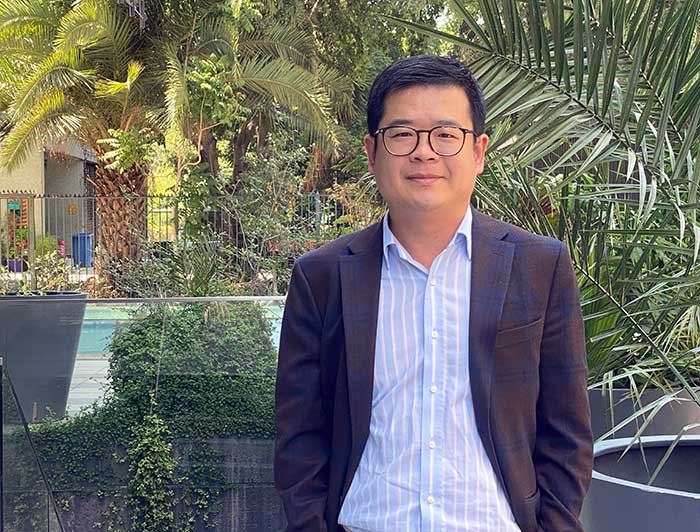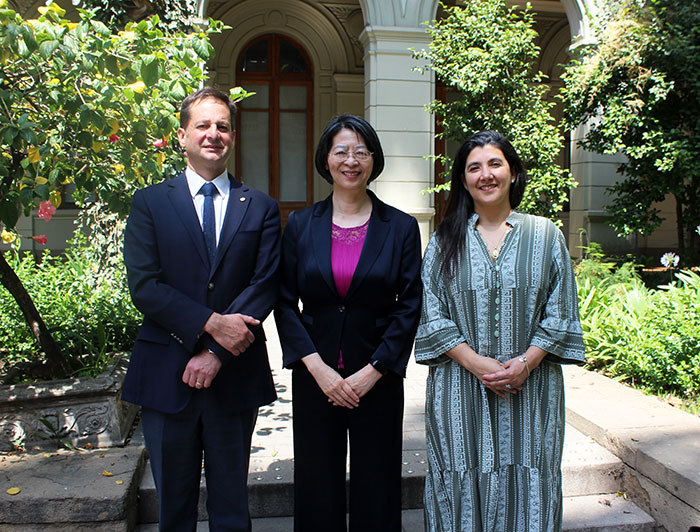To generate joint work initiatives and opportunities for internships and academic exchange, especially in the field of biological and medical sciences, is the objective of the recent visit to UC of a delegation of outstanding researchers from Tsinghua, a leading institution of higher education in China and Asia; among them was the first scientist to obtain a high-resolution image of the coronavirus, contributing greatly to its study and the development of vaccines.

A 15-member delegation from Tsinghua University visited UC between December 10 and 14, with the aim of exploring possible international collaborations between the two institutions, especially in the field of health sciences. (Photo credit: Pía Billa)
It was the beginning of the Covid pandemic, and little was known about the virus that caused it, there were only a few blurred images. Then Dr. Sai Li, a structural biologist and professor in the Department of Life Sciences at Tsinghua University in Beijing, contacted a team of virologists in the city of Hangzhou to provide him with some samples.
Although they had been fixed with chemicals, a procedure that renders them inactive, there was considerable fear. As the researcher says: "I spent almost two months to convince the university that the samples were safe”. He finally succeeded and began his experiments in a biosafety level 3 laboratory - a fairly high standard - on the university campus, which was completely empty because of the pandemic. "There were only four of us: a student, a postdoctoral student, a technician and me," he recalls. The team worked intensively over a 100-day period. "It was very stressful," he confesses.
"We froze the virus at a very, very cold temperature: -190°C, and we had to do it very quickly so that it would freeze in its natural state," he says. He could not make even the slightest mistake during this process, otherwise the ice crystals could pass through the viruses and alter or destroy their structure.
On the other hand, viruses are very small. "They are 100 nanometers in diameter," he says. Optical microscopes cannot see them directly, which is why he had to use a cryo-electron microscope - a technique in which the scientist specializes; the device fired electron beams at the sample, while the image of the virus was reconstructed on the computer.
"What was it like to see the virus for the first time?", I ask him. "It was amazing," he replies. "When we first got the microscope image, we had a screen full of virus, it was very exciting and also, very scary. The virus, to be honest, looks very beautiful. Its shape is very unique. It's very exciting, although my students were a little bit scared, they are very young and they had never seen anything like this before," he relates.
The image went around the world and Dr. Li was even interviewed by the New York Times. His goal was to make the image as public as possible to help the then budding SARS-CoV-2 research. He developed animated images in conjunction with computer vision equipment, with great accuracy in scientific terms.
"When we first got the microscope image, we had a screen full of viruses, it was very exciting and also, very scary" - Sai Li, structural biologist, professor Tsinghua University.
He also contacted the Chinese company CanSino BIO, for the development of one of the first vaccines against Covid, "This uses adenovirus to introduce the antigen sequence into our body, using our body to express the antigens and stimulate the immune response to create specific antibodies against this virus. We then received the vaccines from the company and took a lot of images of the expressed antigens and gave them our recommendations," he explains. Dr. LI's team also imaged the different variants of the virus for comparison.
Currently, Li's lab, composed of a team of 10 people, is finalizing work "that consists of looking at viruses incubated with neutralizing antibodies, we investigate how the antibody neutralizes the virus. We are trying to explore novel mechanisms to explain this neutralization. It is unprecedented work," he says. In addition, he has sub-teams that are working with the influenza and smallpox viruses.

It took Dr. Sai Li and a team of three people 100 days to develop the experiment that allowed him to obtain for the first time a high-resolution image of the coronavirus and analyze its structure (photo credit: Nicole Saffie).
Visit at UC
Dr. Sai Li is part of a 15-member delegation from Tsinghua University, which visited the Catholic University between December 10 and 14. The objective: to explore possible international collaborations between the two institutions, especially in the field of health sciences.
The delegation was received by the Vice Rector for International Affairs Lilian Ferrer, the Vice Rector for Research Pedro Bouchon, and directors of the Faculty of Biological Sciences and Medicine, and the Millennium Institute of Immunology and Immunotherapy (IMII).
"Visits of this type and the creation of spaces that allow us to bilaterally link the research and academic exchange of the Catholic University with those of other universities in the world are extremely important. Tsinghua University is a leader in China, which means that we are working with the best researchers to continue strengthening academic collaboration in important areas such as life sciences," said Vice Rector Lilian Ferrer.
"We maintain close collaboration with Tsinghua University in various fields. During the Covid-19 pandemic, this link was significantly strengthened, prompting the visit of this academic mission composed of researchers specialized in medicine and biological sciences, in order to strengthen cutting-edge research. Without going any further, one of the researchers of the delegation was a key player in the characterization of the virus. In this meeting we seek to strengthen our relationship in order to generate new projects, enhance our doctoral training and academic exchange," says Vice Rector Pedro Bouchon.
At the Faculty of Biological Sciences, the delegation was received by the director of IMII, Alexis Kalergis, and academics Alejandra Alvarez, Gareth Owen and Pablo Gonzalez, all professors of this faculty.
Dr. Qiaoran Xi, Professor of the School of Life Sciences at Tsinghua University, began the bilateral meeting by presenting the main axes of her research in relation to TGF-Beta signaling, cancer and stem cells. Along with this, she made a brief introduction about Tsinghua University and its focus in relation to scientific research and what they are looking for in international collaboration.
This is Professor Qiaoran Xi's first visit to South America and she recognizes that she is very impressed by the UC facilities. She also comments that she sees a collaboration between both universities very possible, "especially in the area of oncology, in the field of neurosciences and immunology", she says. "There are definitely several points in common where there can be collaboration," she adds.
For his part, Professor Li Sai comments that he is pleasantly impressed by the academic level in Chile. Regarding the work in his area, he states that "the focus of Dr. Alexis Kalergis is how effective vaccines are, he develops applied science; while I am working on the mechanisms prior to the development of vaccines, my question is how and why these vaccines are effective, that is, basic science".
However, he sees possible collaboration between laboratories at Tsinghua University and UC, allowing doctoral students to do research internships. "For example, if I get a virus or vaccine construct from Chile, I can send a student here to learn how to grow the cells and propagate the virus, and then come back to analyze the structure, and so on."
Among the challenges, the main one for Professor Qiaoran Xi has to do with funding. "In general, the government provides funding to encourage researchers to collaborate with other countries, but we have not seen any with Chile. So, by returning to China we can see if there is any possibility that they can provide a funding opportunity that, I think, would allow us to improve the connections", says the academic. She also comments that there are several pharmaceutical companies that are financing research projects, as well as Tsinghua University has some funds of its own.
For Professor Li Sai, the greatest challenge is to have biosafety level 3 or 4 laboratories, which are essential for handling highly infectious biological agents with the highest standards, and which are expensive to maintain and require qualified personnel, being very few in the world.
During the working meetings, presentations were also given by Alexis Kalergis, "The Scientific Basis for Vaccine Efficacy and the Immunity Controlling the Covid-19 Pandemic"; Gareth Owen, who delved into advances in relation to studies on cancer cells; and researchers Jing Ma, Suxi Gu, Catterina Farreccio and Julian Varas, who addressed topics such as robotics in surgery, epidemiology, innovation and public health in Chile and China.
Building ties

(L to R) Vice Rector for Research Pedro Bouchon, together with Taotao Chen, Director of the Latin American Center of Tsinghua University and Professor of the School of International Business and Management of Tsinghua University, and Vice Rector for International Affairs Lilian Ferrer (Photo credit: Pia Billa).
This visit is part of a broader context of collaboration between the two universities, which has involved various initiatives.
Last October, the Vice Rector for International Affairs, Lilian Ferrer, visited Tsinghua University, where she was received by the Vice Rector of the Administrative Committee of this institution, Hongwei Wang. Among the points discussed were the interest in jointly deepening aspects of "internationalization at home", academic mobility and development of global competencies. As well as in areas such as astronomy, health, arts and business.
Prior to this meeting, last August, Taotao Chen, professor of the School of Economics and International Management of Tsinghua University, had visited the UC, touring the Innovation Center and the Central House, showing great interest in the academic offerings and advances developed by the Catholic University, in relation to the areas of entrepreneurship, innovation and business at the national level. And previously, in 2022, Dr. Linqi Zhang, professor of the Faculty of Life Sciences, was in Chile as an international guest speaker at the Immunology Symposium organized jointly by the Millennium Institute in Immunology and Immunotherapy (IMII) and the UC.
Also, both universities have developed some joint activities, such as the program "Chile | China Global Conversations About Arts & Culture" and the Summer University Program, which allowed students of International Business, Architecture and Environmental Sciences of Tsinghua University, to visit the campuses and research centers of the UC last August, expressing the intention that UC students can repeat the experience and go to Tsinghua University in 2024.
The above news is from UC, with the original link attached:
https://www.uc.cl/noticias/universidad-de-tsinghua-y-uc-exploran-areas-de-colaboracion-cientifica/